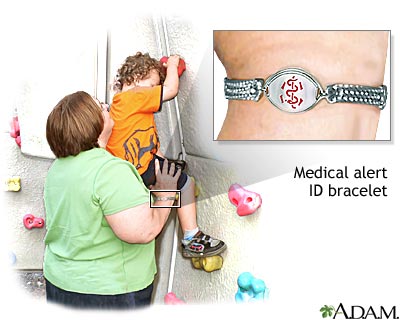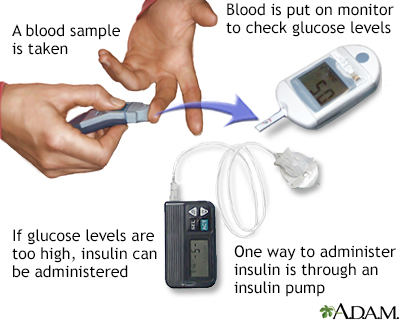Low blood sugar - self-care
Hypoglycemia - self care; Low blood glucose - self care
Images


Description
Low blood sugar is a condition that occurs when your blood sugar (glucose) is lower than normal. Low blood sugar may occur in people with diabetes who are taking insulin or certain other medicines to control their diabetes. Low blood sugar can cause dangerous symptoms. Learn how to recognize the symptoms of low blood sugar and how to prevent them.
What is Low Blood Sugar?
Low blood sugar is called hypoglycemia. A blood sugar level below 70 mg/dL (3.9 mmol/L) is low and can harm you. A blood sugar level below 54 mg/dL (3.0 mmol/L) is a cause for immediate action.
You are at risk for low blood sugar if you have diabetes and are taking any of the following diabetes medicines:
- Insulin
- Glyburide (Micronase), glipizide (Glucotrol), glimepiride (Amaryl), repaglinide (Prandin), or nateglinide (Starlix)
You are also at increased risk of having low blood sugar if you have had previous low blood sugar levels.
Recognizing Low Blood Sugar
Know how to tell when your blood sugar is getting low. Symptoms include:
- Weakness or feeling tired
- Shaking
- Sweating
- Headache
- Hunger
- Feeling uneasy, nervous, or anxious
- Feeling cranky
- Trouble thinking clearly
- Double or blurry vision
- Fast or pounding heartbeat
Sometimes your blood sugar may be too low even if you do not have symptoms. If it gets too low, you may:
Some people who have had diabetes for a long time stop being able to sense low blood sugar. This is called hypoglycemic unawareness. Ask your health care provider if wearing a continuous glucose monitor and sensor can help you detect when your blood sugar is getting too low in order to help prevent symptoms.
Check Your Blood Sugar Often
Talk with your provider about when you should check your blood sugar every day. People who have low blood sugar need to check their blood sugar more often.
The most common causes of low blood sugar are:
- Taking your insulin or diabetes medicine at the wrong time
- Taking too much insulin or diabetes medicine
- Taking insulin to correct high blood sugar without eating any food
- Not eating enough during meals or snacks after you have taken insulin or diabetes medicine
- Skipping meals (this may mean that your dose of long-acting insulin is too high, so you should talk to your provider)
- Waiting too long after taking your medicine to eat your meals
- Exercising a lot or at a time that is unusual for you
- Not checking your blood sugar or not adjusting your insulin dose before exercising
- Drinking alcohol
Preventing Low Blood Sugar
Preventing low blood sugar is better than having to treat it. Always have a source of fast-acting sugar with you.
- When you exercise, check your blood sugar levels. Make sure you have snacks with you.
- Talk to your provider about reducing insulin doses on days that you exercise.
- Ask your provider if you need a bedtime snack to prevent low blood sugar overnight. Protein snacks may be best.
Do not drink alcohol without eating food. Women should limit alcohol to 1 drink a day and men should limit alcohol to 2 drinks a day. Family and friends should know how to help. They should know:
- The symptoms of low blood sugar and how to tell if you have them.
- How much and what kind of food they should give you.
- When to call for emergency help.
- How to inject glucagon, a hormone that increases your blood sugar. Your provider will tell you when to use this medicine.
If you have diabetes, always wear a medical alert bracelet or necklace. This helps emergency medical workers know you have diabetes.
When Your Blood Sugar Gets Low
Check your blood sugar whenever you have symptoms of low blood sugar. If your blood sugar is below 70 mg/dL, treat yourself right away.
1. Eat something that has about 15 grams (g) of carbohydrates. Examples are:
- 4 glucose tablets
- One half cup (4 ounces or 120 mL) of fruit juice or regular, non-diet soda
- 5 or 6 hard candies
- 1 tablespoon (tbsp) or 15 mL of sugar, plain or dissolved in water
- 1 tbsp (15 mL) of honey or syrup
2. Wait about 15 minutes before eating any more. Be careful not to eat too much. This can cause high blood sugar and weight gain.
3. Check your blood sugar again.
4. If you do not feel better in 15 minutes and your blood sugar is still lower than 70 mg/dL (3.9 mmol/L), eat another snack with 15 g of carbohydrates.
You may need to eat a snack with carbohydrates and protein if your blood sugar is in a safer range -- over 70 mg/dL (3.9 mmol/L) -- and your next meal is more than an hour away.
Ask your provider how to manage this situation. If these steps for raising your blood sugar do not work, contact your provider right away.
Talk to Your Doctor or Nurse
If you use insulin and your blood sugar is frequently or consistently low, ask your provider or nurse if you:
- Are injecting your insulin the right way
- Need a different type of needle
- Should change how much insulin you take
- Should change the kind of insulin you take
Do not make any changes without talking to your provider or nurse first.
Sometimes hypoglycemia can be due to accidently taking the wrong medicines. Check your medicines with your pharmacist.
When to Call the Doctor
If signs of low blood sugar do not improve after you have eaten a snack that contains sugar, have someone drive you to the emergency room or call 911 or the local emergency number. Do not drive when your blood sugar is low.
Get medical help right away for a person with low blood sugar if the person is not alert or cannot be woken up as this is a medical emergency.
Related Information
Type 1 diabetesType 2 diabetes
Diabetes - when you are sick
Diabetes - preventing heart attack and stroke
Diabetes - taking care of your feet
Diabetes tests and checkups
Diabetes and exercise
Diabetes - keeping active
Managing your blood sugar
Diabetes - foot ulcers
Diabetes eye care
ACE inhibitors
Type 2 diabetes - what to ask your doctor
References
American Diabetes Association Professional Practice Committee. 6. Glycemic Goals and Hypoglycemia: Standards of Care in Diabetes-2024. Diabetes Care. 2024;47(Suppl 1):S111-S125. PMID: 38078586 pubmed.ncbi.nlm.nih.gov/38078586/.
Cryer PE, Arbeláez AM. Hypoglycemia. In: Melmed S, Auchus RJ, Goldfine AB, Koenig RJ, Rosen CJ, eds. Williams Textbook of Endocrinology. 14th ed. Philadelphia, PA: Elsevier; 2020:chap 38.
BACK TO TOPReview Date: 2/28/2024
Reviewed By: Sandeep K. Dhaliwal, MD, board-certified in Diabetes, Endocrinology, and Metabolism, Springfield, VA. Also reviewed by David C. Dugdale, MD, Medical Director, Brenda Conaway, Editorial Director, and the A.D.A.M. Editorial team.

Health Content Provider
06/01/2025
|
A.D.A.M., Inc. is accredited by URAC, for Health Content Provider (www.urac.org). URAC's accreditation program is an independent audit to verify that A.D.A.M. follows rigorous standards of quality and accountability. A.D.A.M. is among the first to achieve this important distinction for online health information and services. Learn more about A.D.A.M.'s editorial policy, editorial process and privacy policy. A.D.A.M. is also a founding member of Hi-Ethics. This site complied with the HONcode standard for trustworthy health information from 1995 to 2022, after which HON (Health On the Net, a not-for-profit organization that promoted transparent and reliable health information online) was discontinued. |
The information provided herein should not be used during any medical emergency or for the diagnosis or treatment of any medical condition. A licensed medical professional should be consulted for diagnosis and treatment of any and all medical conditions. Links to other sites are provided for information only -- they do not constitute endorsements of those other sites. © 1997- 2025 A.D.A.M., a business unit of Ebix, Inc. Any duplication or distribution of the information contained herein is strictly prohibited.
